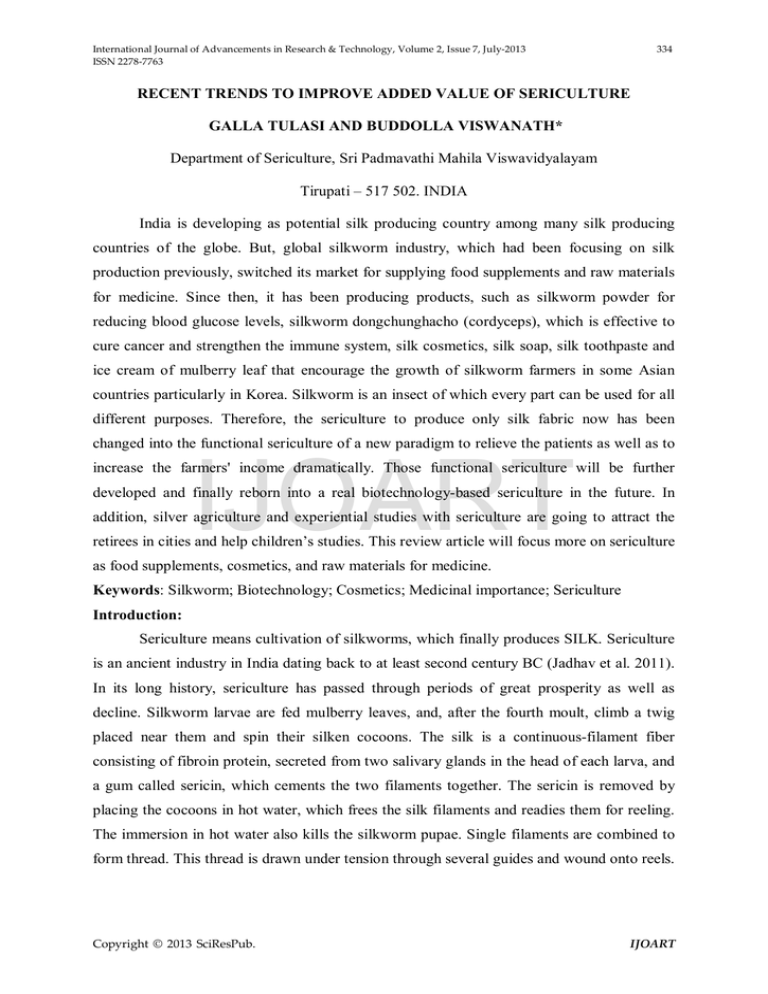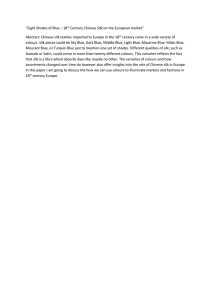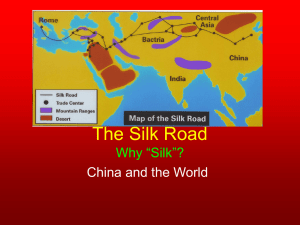Document 14681213
advertisement

International Journal of Advancements in Research & Technology, Volume 2, Issue 7, July-2013 ISSN 2278-7763 334 RECENT TRENDS TO IMPROVE ADDED VALUE OF SERICULTURE GALLA TULASI AND BUDDOLLA VISWANATH* Department of Sericulture, Sri Padmavathi Mahila Viswavidyalayam Tirupati – 517 502. INDIA India is developing as potential silk producing country among many silk producing countries of the globe. But, global silkworm industry, which had been focusing on silk production previously, switched its market for supplying food supplements and raw materials for medicine. Since then, it has been producing products, such as silkworm powder for reducing blood glucose levels, silkworm dongchunghacho (cordyceps), which is effective to cure cancer and strengthen the immune system, silk cosmetics, silk soap, silk toothpaste and ice cream of mulberry leaf that encourage the growth of silkworm farmers in some Asian countries particularly in Korea. Silkworm is an insect of which every part can be used for all different purposes. Therefore, the sericulture to produce only silk fabric now has been IJOART changed into the functional sericulture of a new paradigm to relieve the patients as well as to increase the farmers' income dramatically. Those functional sericulture will be further developed and finally reborn into a real biotechnology-based sericulture in the future. In addition, silver agriculture and experiential studies with sericulture are going to attract the retirees in cities and help children’s studies. This review article will focus more on sericulture as food supplements, cosmetics, and raw materials for medicine. Keywords: Silkworm; Biotechnology; Cosmetics; Medicinal importance; Sericulture Introduction: Sericulture means cultivation of silkworms, which finally produces SILK. Sericulture is an ancient industry in India dating back to at least second century BC (Jadhav et al. 2011). In its long history, sericulture has passed through periods of great prosperity as well as decline. Silkworm larvae are fed mulberry leaves, and, after the fourth moult, climb a twig placed near them and spin their silken cocoons. The silk is a continuous-filament fiber consisting of fibroin protein, secreted from two salivary glands in the head of each larva, and a gum called sericin, which cements the two filaments together. The sericin is removed by placing the cocoons in hot water, which frees the silk filaments and readies them for reeling. The immersion in hot water also kills the silkworm pupae. Single filaments are combined to form thread. This thread is drawn under tension through several guides and wound onto reels. Copyright © 2013 SciResPub. IJOART International Journal of Advancements in Research & Technology, Volume 2, Issue 7, July-2013 ISSN 2278-7763 335 The threads may be plied together to form yarn. After drying the raw silk is packed according to quality. As stated earlier, India is developing as potential silk producing country among many silk producing countries of the globe. However, global silkworm industry, which had been focusing on silk production previously, switched its market for supplying food supplements and raw materials for medicine. Since then, it has been producing products, such as silkworm powder for reducing blood glucose levels, silkworm dongchunghacho (cordyceps), which is effective to cure cancer and strengthen the immune system, silk cosmetics, silk soap, silk toothpaste and ice cream of mulberry leaf that encourage the growth of silkworm farmers in some Asian countries particularly in Korea. Here in the article we are focusing more on sericulture as food supplements, cosmetics, and raw materials for medicine Mulberry Leaves Mulberry leaves are rich in calcium, phosphorus, magnesium, vitamins, B, C and K. They also contain antioxidants particularly the anthocyanins and the flavonoids quercetin and kaempferol. the leaves contain 18 amino acids. IJOART Silk is a natural protein fiber, some forms of which can be woven into textiles. The best-known type of silk is obtained from the cocoons of the larvae of the mulberry silkworm Bombyx mori reared in captivity (sericulture). The shimmering appearance of silk is due to the triangular prism-like structure of the silk fiber, which allows silk cloth to refract incoming light at different angles, thus producing different colors. Traditional Uses of Mulberry In India, the leaves serve as food for cattle & goats, the pruned shoots are used as firewood. The wood is used in making scaffolding, furniture, panellings, plywood, toys, sports goods. Some parts of the wood are used to make carriages and carts. The branches of the mulberry tree are used to make baskets. From the bark of the stem of the Morus alba tree, paper is made. Health Benefits of Mulberries In ayurvedic medicines, various parts of the mulberry plant are used. • From the leaves a gargle is prepared for throat infections. • The fruits are used in fever, depression, and sore throat as they are cooling. • The root bark is used as purgative and anthelmintic. • The juice of the root is used to treat high blood pressure. • Chinese use the tips of the young leaves to make a tea to control blood pressure. • The latex is used as plaster for sores and in skin creams. Copyright © 2013 SciResPub. IJOART International Journal of Advancements in Research & Technology, Volume 2, Issue 7, July-2013 ISSN 2278-7763 336 • Mulberries reduce cholesterol, prevent blood clots, heart palpitations etc. • Mulberries aid in weight loss, build immunity, benefit the digestive system and eyesight, relieve constipation and enhance appetite and checks anemia. • they benefit hair growth, soothe the nerves, relieve tiredness and fatigue. • Mulberries benefits in gastritis, hepatitis dizziness and insomnia. • Mulberries control excessive thirst, relieve phlegm, purifies the blood. • Consuming mulberries during the hot season benefits in blood disorders and has a cooling effect on the body. • Excessive yellowness of the urine is controlled by consuming mulberry juice to which sugar has been added. • In mouth ulcers and enlarged glands, gargle with a solution of mulberry sherbet. Add 1 tsp of mulberry sherbet to a cup of water to make this water solution. Nutrients in Mulberry Mulberries are a literal powerhouse of nutrition. They are very rich in Vitamins B, C, K and the element iron. Good levels of fiber, riboflavin, phosphorus, copper, magnesium, IJOART potassium and calcium are also found in mulberries (Table 1). Also they are an excellent source of the antioxidants resveratrol, zeaxanthin, lutein,and to a lesser extent the alpha & beta carotene. Table 1: Mulberry Fresh, raw ( Nutrition Value per 100 g) Principle Nutrient Value Energy 43 Kcal Carbohydrates 9.80 g Protein 1.44 g Total Fat 0.39 g Cholesterol 0 mg Dietary Fiber 1.7 g Vitamins Folates 6 mcg Niacin 0.620 mg Pyridoxine 0.050 mg Riboflavin 0.101 mg Vitamin A 25 IU Vitamin C 36.4 mg Vitamin E 0.87 mg Vitamin K 7.8 mcg Electrolytes Sodium 10 mg Potassium 194 mg Minerals Calcium 39 mg Copyright © 2013 SciResPub. IJOART International Journal of Advancements in Research & Technology, Volume 2, Issue 7, July-2013 ISSN 2278-7763 Copper Iron Magnesium Selenium Zinc Carotene--ß Carotene, ? Lutein-zeaxanthin 337 60 mcg 1.85 mg 18 mg 0.6 mcg 0.12 mg Phyto-nutrients 9 mcg 12 mcg 136 mcg Mulberry Tea The mulberry tea is caffeine free and made from mulberry leaves. Mulberry tea maybe slightly laxative , controls inflammations of the mucus membranes of the respiratory tract. The tea relieves colds, coughs, throat infections, inflammations of the eyes, liver and lung problems, supposed to prevent oxidation of cholesterol consequently keeping the arteries free of fat deposits and hence hardening of arteries. IJOART Silk (a natural protein fiber): Silk is a natural protein fiber, some forms of which can be woven into textiles. The best-known type of silk is obtained from the cocoons of the larvae of the mulberry silkworm Bombyx mori reared in captivity (sericulture). Silks are produced by several other insects, but generally only the silk of moth caterpillars has been used for textile manufacturing. There has been some research into other silks, which differ at the molecular level. Many silks are mainly produced by the larvae of insects undergoing complete metamorphosis, but some adult insects such as webspinners produce silk, and some insects such as raspy crickets produce silk throughout their lives. Silk production production also occurs in Hymenoptera (bees, wasps, and ants), silverfish, mayflies, thrips, leafhoppers, beetles, lacewings, fleas, flies and midges. Other types of arthropod produce silk, most notably various arachnids such as spiders (see spider silk). Chemical Properties of Silk: • Silk emitted by the silkworm consists of two main proteins, sericin and fibroin, fibroin being the structural center of the silk, and serecin being the sticky material surrounding it. • Fibroin is made up of the amino acids Gly-Ser-Gly-Ala-Gly-Ala and forms beta pleated sheets. Hydrogen bonds form between chains, and side chains form above and below the plane of the hydrogen bond network. Copyright © 2013 SciResPub. IJOART International Journal of Advancements in Research & Technology, Volume 2, Issue 7, July-2013 ISSN 2278-7763 338 Tab le 2. The Co mpo sition of Amino Aci d in Silk Amino Acids( %) Amino Acid • Compo sition Amino Acid Composition • Aspart at e • 0.17 • Valine • 0.50 • Glut amat e • 1.03 • Met hio inine • 0.04 • Ser ine • 7.17 • Phen ylalan ine • 0.02 • Glyc ine • 46.39 • Iso leu cine • 0.08 • Threo nine • 0.15 • Cyst eine • 0.02 • Alanine • 44.55 • T yro sine • 0.14 • Arginine • 0.17 • Lys ine • 0.07 • Leucine • 0.05 • Pro line • 0.02 IJOART The high proportion (50%) of glycine, which is a small amino acid, allows tight packing and the fibers are strong and resistant to breaking. • The tensile strength is due to the many interseeded hydrogen bonds, and when stretched the force is applied to these numerous bonds and they do not break. • Silk is resistant to most mineral acids, except for sulfuric acid, which dissolves it. It is yellowed by perspiration. The fo llowing Table 2. illust rat ed t he co mposit io n o f amino ac id in S ilk Amino Acids(%). A. Miracle Health Food (Silkworm-Dongchunghacho/ Tochukaso/ Cordyceps) Scientists Turn to Silk Strands for Surgery, Circuits (Synthetic silk could be the next big thing in biotechnology) Dongchunghacho is a fungus living inside the body of the larva or the image of insects in winter and later grows outside the body in the form of mushroom in summer. It is not only an animal but also a plant and known to have a miraculous energy. It has been called 'a mystic miraculous medicine for eternal youth' or 'a legendary elixir of life' for a long time (Kang-Sun Ryu 2011). Institute of Agricultural Science & Technology under Rural Development Administration, a Korea government authority, has succeeded as a result of their research for several years in inoculating the cultivated fungus in the body of silkworm after they collected the wild Copyright © 2013 SciResPub. IJOART International Journal of Advancements in Research & Technology, Volume 2, Issue 7, July-2013 ISSN 2278-7763 339 Dongchunghacho, separated only the pure fungus, and sorted out two types (Japonica and P.spJ300). It was the first time ever in the world that Silkworm-Dongchunghacho cultivating on alive silkworm was developed and finally became possible to be produced in a large quantity. • Under the patented technology the Paecilomyces japonica (tenuipes) fungus are spreaded on the surface of live silkworm, leaded to be infected like a natural worm, and cultivated in the form of a mushroom from the infected pupa. • Both the mushroom and the infected pupa, a host, are eaten together. • It is registered as a breed name 'Silkworm Dongchunghacho' under the government's law for the quality maintenance of agricultural products. It is controlled by Korea Food Code to use Silkworm-Dongchunghacho as a raw material for food and is protected legally. • The important feature is that the Silkworm-Dongchunghacho has the outstanding medical effect. IJOART The medical effect of Silkworm-Dongchunghacho The medical effects acknowledged by the Natural Products Research Institute of Seoul National University in Korea are as follows: 1) Anti-cancer - Effect of extending life: 203% & Effect of anti-solid cancer: 59% 2) Protection of liver - Remarkable effect of restraining active GOT and GPT 3) Anti-fatigue - 1.5times effect compared to the medicine "Tocopherol" 4) Strengthening immunocompetence - Double effect compared to the medicine "Zymosan" 5) Anti-stress - Remarkable effect for recovery of various intestine weight (adrenal, spleen, thyroid gland) changed caused by the stress 6) Anti-aging - Powerful skin and restraining the oxidation reaction The virtue of Silkworm- Dongchunghacho Good for strengthening the vigour, anti-cancer, arteriosclerosis, hypertension, heart disease, decrepitude, renal disease, hepatitis, allergic dermatitis, asthma, fatigue recovery, insomnia, constipation, brain disease, and elastic skins. Silk is an amazing ingredient: Silk Amino Acids are natural water-soluble source of acid derived from liquid silk; these acids help moisture penetrate the skin and aid in skin healing. Copyright © 2013 SciResPub. IJOART International Journal of Advancements in Research & Technology, Volume 2, Issue 7, July-2013 ISSN 2278-7763 340 Silk Amino Acids add a 'silky' lather to soaps and also have moisture binding properties. This luxurious recipe blends the silky and softening properties of liquid Silk amino acids in our mild soap base to create an exquisite, silky, smooth, rich lather. This soap has the added benefits of real silk in every bar! The use of Silk in cosmetics: Research has found that silk has moisture retention qualities and UV ray blocking properties. Silk Cream (100% Fragrance Free): Smiss Silk Cream is a natural beauty cream for the face. It contains pure natural silk. The silk's 18 (eighteen) amino acids are absorbed instantly to nourish the skin and make it moist. Smiss Silk Cream protects the skin from pollutants, windburn, sunburn and is especially suitable for sensitive skin. enjoy the pleasure of a more youthful looking appearance. Silk Night Cream (100% Fragrance Free): Smiss Silk Night Cream contains Silk Peptide, Silk Amino Acids, Aloe Vera and Jojoba Oil. It regulates moisture balance during the night to nourish and rejuvenate the skin. IJOART Smiss Silk Night Cream assists the flight against wrinkles and fine line. Smiss Natural Silk Lotion: Smiss Natural Silk Lotion contains rich silk protein and silk peptide, which are good moisturizers to keep your skin soft and moist. Regular use will help keep the skin soft, silkysmooth and always youthful looking. Smiss Natural Silk Lotion is for all types of skin. Silk Hand Cream (100% Fragrance Free): Smiss Silk Cream smoothes and softens rough hands .This natural hand cream is nongreasy and contains rich silk essence which gives the hands a silky, smooth, luxuriant feel .Apply silk hand cream regularly and feel the difference. Silk Baby Cream: One million mothers proclaim that Smiss baby cream is a safe and effective products , Smiss baby cream is made from high quality nutritional elements, natural silk peptide and raw greasy lanolin which work together to protects the baby's tender skin. It is easily to absorbed and forms a protective film on the skin ,which reduces water evaporation. This helps alleviate skin irritations caused by the environment. This cream resists cracking and wrinkling of skin ;anti-wrinkle results are excellent. It guarantees a healthier, livelier and tender baby. SILK toothpaste: Copyright © 2013 SciResPub. IJOART International Journal of Advancements in Research & Technology, Volume 2, Issue 7, July-2013 ISSN 2278-7763 341 SILK toothpaste is a pure natural health protection toothpaste.It contains the surface growth factors of the activated natural material EGF and silk. In this way, it helps cells grow, absorb nutrition, sterilize, diminish inflammation, prevent bleeding, ease pain, and heal wounds. Conclusion: Thus it is the time to switch sericulture industry from the wearing silk material to supplying functional food supplements for human medicinal use, silk as cosmetics and other commercial purposes. Therefore, the sericulture to produce only silk fabric now has been changed into the functional sericulture of a new paradigm to relieve the patients as well as to increase the farmers' income dramatically. Those functional sericulture will be further developed and finally reborn into a real biotechnology-based sericulture in the future. References: Nikoleishvili G (2005) Ways of perfection of application of the potential of economic efficacy of sericulture in market economy conditions. Tbilisi, 2005, p.93-104. IJOART Kang-Sun Ryu (2011) The research trend for improving added value of sericulture. 5th Bacsa international conference “sericulture for multi products – new prospects for development” April 11th – 15th 2011 Bucharest, Romania (Proceedings) Jadhav AD, Sathe TV, Dubal RS, Yankanchi SR, Bhusnar AR and Muley DV (2011) The research trend for improving added value of sericulture. 5th Bacsa international conference “sericulture for multi products – new prospects for development” April 11th – 15th 2011 Bucharest, Romania (Proceedings) Copyright © 2013 SciResPub. IJOART







